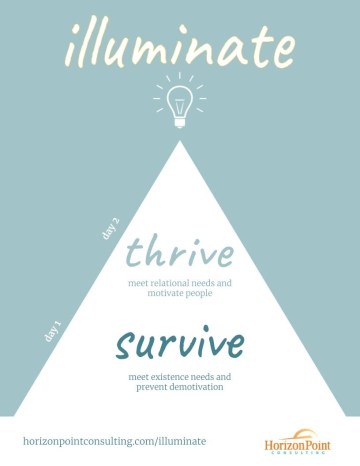“Certain ideological systems and work environments are broken. In this age, it’s up to change makers, risk-takers, and the faithful to repair or start fresh when our contexts aren’t bearing fruit for the common good.”
Michaela O’Donnell, PhD in Make Work Matter
It’s the end of January 2022 as I write this and I’ve already had about half a dozen requests since the beginning of the year to speak on or facilitate sessions related to workplace retention. Whether you want to frame it as the great resignation, the labor participation rate, COVID still wreaking havoc, or nobody wanting to work anymore, workplace engagement and therefore retention is at what many people feel is an all time low. Business leaders are scrambling, because it is impacting business outcomes.
In one of these recent sessions, one person began to rant about people “not being like they used to be.” I had gotten to the point where I had heard enough, and I asked him (in a way that I hope came across as polite) what he was doing at his company to adapt to this new reality. He looked at me dumbfounded while the gentleman sitting next to him grinned and started to rattle off the ways in the last six months they’ve changed their people practices -really their whole paradigm around how to get work done- and how it’s working. These two men who were sitting side by side are competitors in a way. In a historically traditional industry. I know who’d I go to work for and who I’d buy a product from. The one who is adapting, the one who is innovating, instead of the one who is complaining. I bet their turnover rates compared to one another tell the same story.
When I went back to do a search on one of the three things that create a thriving workplace, doing a search for the words “autonomy”, “flexibility”, and “freedom” on our blog, the first post I could find took me back almost ten years to 2012 right after I started Horizon Point in 2011. Apparently I have been talking about these things for over ten years, advocating for us to think differently about what and where it means to work.
We’ve yet to find a better structure for organizing what people need to thrive in the workplace than what Daniel Pink outlines in Drive. It’s 1) Autonomy 2) Mastery 3) Purpose.
So here is a collection of blog posts and thoughts, dating back 10 years, linked to these needs:
1 . Autonomy:
Autonomy and Productivity Together Can Be Better
How Innovative Companies Go About Rule Making
The Name of the Game is Freedom: How Innovative Companies Motivate and Retain the Best
Flexibility to Reduce Workplace Stressors
Punching the Time Clock May Not Be All It’s Cracked Up to Be
2. Mastery:
Mastery is being able to learn and continuously improve and get good, really good at something. It requires several things to achieve, but we are finding more and more what is critically missing from people getting there (and finding purpose) is margins. Margin being the ability to have time to think, process information, and be able to apply creative thinking to solve problems, learn and grow and actually enjoy doing it.
Here are a couple of posts to help you think about margin:
Take a Lunch Break
6 Ways to Build Energy
Also refer back to our Survive post on doing a time tracking exercise to also help examine margin and times of peak productivity that can help to lead to mastery.
And finally, mastery usually is built towards during periods of flow:
5 Questions to Ask Yourself about Flow in the Workplace
3. Purpose: The final pillar of building a workplace where people thrive is building purpose. We believe you do this by establishing company mission, vision, and values and hiring and retaining people that align with your organization’s values. Food for thought on this pillar can be found in these posts:
What are Company Values and How Do You Create Them?
6 Ways to Design Your Performance Management System Around Values
7 Ways to Supercharge Employee Engagement
A Series of Posts on Mission Statements
What happens when we stack the pyramid in our favor? Innovation happens. And innovation is an absolute necessity in today’s VUCA world. But we often limit innovation to products or processes and we don’t think about innovating people practices.

That’s why we’ve launched Illuminate, to help you actually spend the time innovating your people practices. Join us today- seats are limited.







